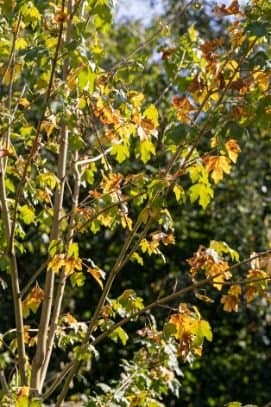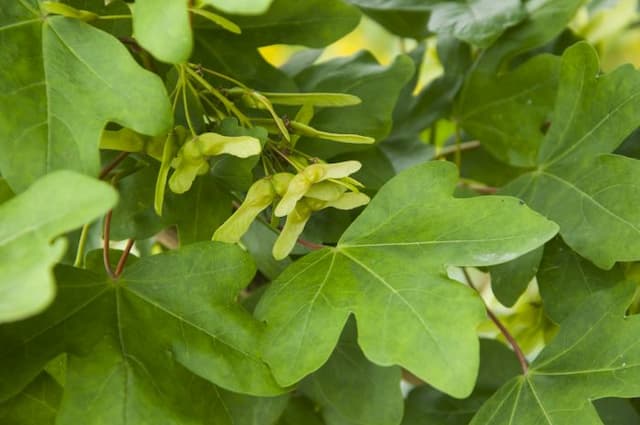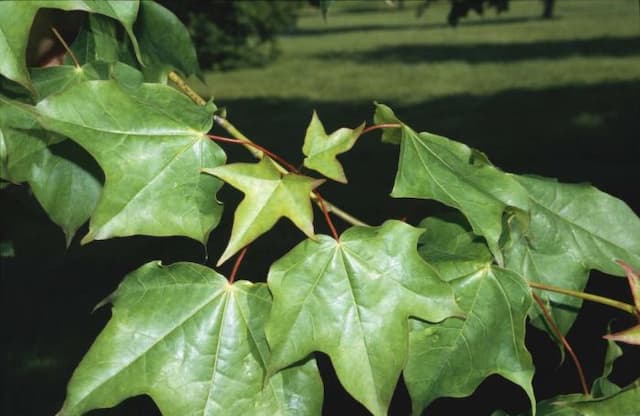Manchurian striped maple Acer tegmentosum

ABOUT
Acer tegmentosum, commonly known as Manchurian striped maple, is a plant recognized for its distinctive ornamental features. It is a deciduous tree, which means it sheds its leaves annually. The leaves are arranged in an opposite fashion along the branches and are characteristically palmate, meaning they have several lobes emanating from a central point, resembling a hand. These lobes are usually elongated and come to a point, with toothed edges providing a somewhat delicate texture. The foliage is not only known for its shape but also for its color. During the growing season, the leaves display a rich green hue, which transitions into vibrant yellows and occasionally reds in the autumn, creating a stunning display against the landscape. Another notable feature is the bark, which makes the Manchurian striped maple particularly distinctive. The bark is greenish-grey and smooth when young, but as the tree matures, it develops striking vertical white stripes that contrast with the underlying darker tones, giving it a unique and attractive appearance. The plant is also adorned with flowers in the spring, which are small and appear in clusters. The flowers are typically a subtle yellow-green color and may not be as conspicuous as the leaves or the bark. Following the flowering period, the plant produces winged seeds that are arranged in pairs, each with a slight V-shape, commonly found in maples. These seeds, known as samaras, can be seen twirling to the ground like helicopters when they detach from the tree. Manchurian striped maple's visual appeal is further enhanced by its gracefully spreading branches, which contribute to its overall shape and silhouette in the landscape. Its aesthetic qualities make it popular among gardeners and landscape architects who wish to incorporate visually interesting and unique plants into their designs.
About this plant
 Names
NamesFamily
Sapindaceae.
Synonyms
Manchurian Striped Maple, Korean Striped Maple.
Common names
Acer tegmentosum Maxim., Acer pensylvanicum subsp. tegmentosum (Maxim.) E.Murray, Acer pensylvanicum var. tegmentosum (Maxim.) Wesm.
 Toxicity
ToxicityTo humans
Acer tegmentosum, commonly known as Manchurian striped maple, does not have a reputation for being toxic to humans. There are no well-documented cases or symptoms associated with poisoning in humans resulting from ingestion of any part of the Manchurian striped maple.
To pets
Manchurian striped maple is not commonly listed as a toxic plant to pets. However, it is always wise to prevent pets from ingesting plants, as individual reactions can vary, and the potential for gastrointestinal upset or more serious conditions could arise if a pet consumes a significant amount of plant material.
 Characteristics
CharacteristicsLife cycle
Perennials
Foliage type
Deciduous
Color of leaves
Green
Flower color
Yellow
Height
20 feet [6 meters]
Spread
20 feet [6 meters]
Plant type
Tree
Hardiness zones
4
Native area
Asia
Benefits
 General Benefits
General Benefits- Landscape Aesthetics: Acer tegmentosum, commonly known as Manchurian striped maple, adds visual interest to landscapes with its distinctive green and white striped bark.
- Shade: Like other maples, it provides shade in gardens and parks, making outdoor spaces more comfortable during sunny days.
- Wildlife Habitat: The tree offers habitat and food for wildlife, such as birds and squirrels, through its canopy and seeds.
- Seasonal Interest: It exhibits seasonal changes that contribute to the year-round appeal of an area, with vibrant foliage in the fall.
- Erosion Control: The root system can help stabilize soil and prevent erosion on slopes or in areas prone to soil loss.
 Medical Properties
Medical Properties- Anti-inflammatory: Acer tegmentosum may possess anti-inflammatory properties.
- Antioxidant: The plant has been suggested to have antioxidant effects.
- Liver protection: There is some indication that Acer tegmentosum could offer liver-protective benefits.
- Anti-hyperglycemic: It might help in managing blood sugar levels which implies potential use in diabetes management.
- Neuroprotective effects: The plant may have compounds that can protect against neurological diseases.
 Air-purifying Qualities
Air-purifying QualitiesThis plant is not specifically known for air purifying qualities.
 Other Uses
Other Uses- Manchurian Striped Maple wood can be used for crafting musical instruments, such as violins and guitars, due to its aesthetic appeal and sound resonance traits.
- The bark of the Manchurian Striped Maple is sometimes used in traditional dyeing processes to achieve varying shades of brown and gray textiles.
- The tree's sap can be tapped and processed into syrup similarly to its relative, the sugar maple, providing a unique, sweet flavoring.
- In landscape design, Manchurian Striped Maple is valued for its distinctive bark stripes, and is used to create visually appealing contrasts in gardens and parks.
- As a bonsai, the Manchurian Striped Maple is an attractive choice for enthusiasts looking to cultivate its miniature form.
- The fallen leaves of the tree can be collected to make a natural mulch, which can help retain soil moisture and suppress weeds.
- Wood from the Manchurian Striped Maple can be used for specialized products like fine veneers for furniture and interior decoration, owing to its pattern and color.
- The tree is sometimes planted as part of efforts to restore native forests and ecosystems, owing to its ability to thrive in local conditions.
- In woodworking, small branches and twigs of this maple can be utilized to make decorative items and intricate wooden jewelry.
- The presence of Manchurian Striped Maples in urban settings can provide habitat and support for local wildlife, including birds and beneficial insects.
Interesting Facts
 Feng Shui
Feng ShuiThe plant_name is not used in Feng Shui practice.
 Zodiac Sign Compitability
Zodiac Sign CompitabilityThe plant_name is not used in astrology practice.
 Plant Symbolism
Plant Symbolism- Strength: Acer tegmentosum, commonly known as the Manchurian striped maple, has wood that is valued for its sturdiness, which symbolizes strength and endurance.
- Resilience: The Manchurian striped maple is renowned for its ability to withstand harsh climates, making it a symbol of resilience and adaptability.
- Beauty: With its distinctively striped bark and attractive foliage, the Manchurian striped maple represents beauty and elegance in the natural world.
- Growth: As a maple tree species, it is commonly associated with growth and development, both spiritually and physically.
- Longevity: Maples, in general, can have a long life span, and therefore Acer tegmentosum is often associated with longevity and timelessness.
 Water
WaterFor the Manchurian striped maple, establish a consistent watering schedule, providing the plant with about 1 to 1.5 inches of water weekly during its growing season, depending on weather conditions. Reduce watering during the winter months when the plant is dormant. It's important to water deeply to encourage root growth, which can be achieved by slow irrigation that allows the water to soak into the soil rather than run off. In dry conditions, it may need additional water, but making sure the soil is well-draining will prevent waterlogging, which can lead to root rot. During extreme heat, water the tree a couple of times a week, adjusting the amount to about 10 gallons for each watering session to ensure it receives enough moisture.
 Light
LightManchurian striped maple prefers a location that offers full sun to partial shade. The ideal spot would receive morning sunlight and afternoon shade, particularly in regions where the afternoon sun is intense. Proper light conditions will ensure vibrant foliage and a healthy growth rate, but beware that too much intense sun can scorch the leaves.
 Temperature
TemperatureManchurian striped maple flourishes in a wide range of temperatures but grows best in temperatures between 60°F and 80°F. It can withstand minimum winter temperatures down to -20°F without damage, making it suitable for growth in many temperate regions. Protecting the tree from extreme cold by placing it in a sheltered location can help minimize frost damage.
 Pruning
PruningPrune the Manchurian striped maple to maintain its shape and health, removing any dead or damaged branches. The best time to prune is during the late winter or early spring before new growth starts. Prune sparingly, as this maple does not usually require heavy pruning, and focus on opening up the tree's canopy to light and air circulation. Pruning every 2 to 3 years should suffice unless there's damage or disease that needs to be addressed sooner.
 Cleaning
CleaningAs needed
 Soil
SoilManchurian Striped Maple prefers well-draining, fertile soil with a slightly acidic to neutral pH between 5.5 and 7.5. A mix containing loam, peat or compost, and some sand or perlite is ideal for ensuring proper drainage and nutrient retention. Regularly enriching the soil with organic matter will support healthy growth.
 Repotting
RepottingManchurian Striped Maple, being a tree, is not typically repotted. Instead, it's planted outdoors where it seldom requires transplanting. If grown in a container, young trees may require repotting every 2-3 years to accommodate root growth, using a larger pot each time.
 Humidity & Misting
Humidity & MistingManchurian Striped Maple thrives in average outdoor humidity levels. It does not require specific humidity conditions indoors but benefits from the natural fluctuations of outdoor environments. Excessive humidity, however, should be avoided to prevent disease issues.
 Suitable locations
Suitable locationsIndoor
Provide bright indirect light, consistent moisture, and good air circulation.
Outdoor
Plant in well-draining soil, full sun to partial shade, shelter from wind.
Hardiness zone
4-8 USDA
 Life cycle
Life cycleAcer tegmentosum, commonly known as Manchurian striped maple, begins its life cycle as a seed, which requires stratification to break dormancy and germinate. Upon germination in the spring, the seedling develops into a small tree with characteristic green-white striped bark. As the sapling grows, it undergoes primary growth elongating its stem and secondary growth increasing its girth, while developing a distinctive leaf pattern of three lobes with serrated edges. The tree reaches maturity after several years, producing small yellow flowers which, after pollination, develop into winged samaras that disperse with the wind in late summer or autumn. These samaras land in suitable environments and, when conditions are favorable, germinate to begin a new generation. Throughout its life, the Manchurian striped maple experiences cycles of dormancy during the winter, with growth resuming each spring.
 Propogation
PropogationPropogation time
Spring to Summer
Propogation: The most popular method of propagation for Acer tegmentosum, commonly known as the Manchurian striped maple, is by seed. Seeds require stratification to break dormancy, a process that involves exposing them to cold temperatures for a period, typically about 90 to 120 days. This mimics the natural winter conditions that the seeds would experience in the wild. To propagate, seeds should be sown in fall, allowing them to stratify naturally over the winter, or they can be mixed with moist sand and placed in the refrigerator at about 34 to 41 degrees Fahrenheit (1 to 5 degrees Celsius) if sown in spring. After stratification, seeds can be sown in a well-draining soil mix, covered lightly with soil, and kept at a temperature of around 70 degrees Fahrenheit (21 degrees Celsius) until germination, which usually occurs within a few weeks.







![Freeman maple [Autumn Blaze]](/_next/image?url=https%3A%2F%2Fplants-admin.emdemapps.com%2Fimages%2Fplants%2F%2Fimages%2F604b575b84d87.png&w=640&q=75)

